Gorilla trekking is one of (if not) the top experiences African Safari experiences for all visitors who get the chance to meet the mountain gorillas and see them in person. The fact that the experiences can only be enjoyed in a small natural area of the Virungas and Bwindi also adds to making gorilla trekking special.
For those who have had the chance to see gorillas in the wild, and spend time with them, you know how difficult it is to capture the feelings of the experience.
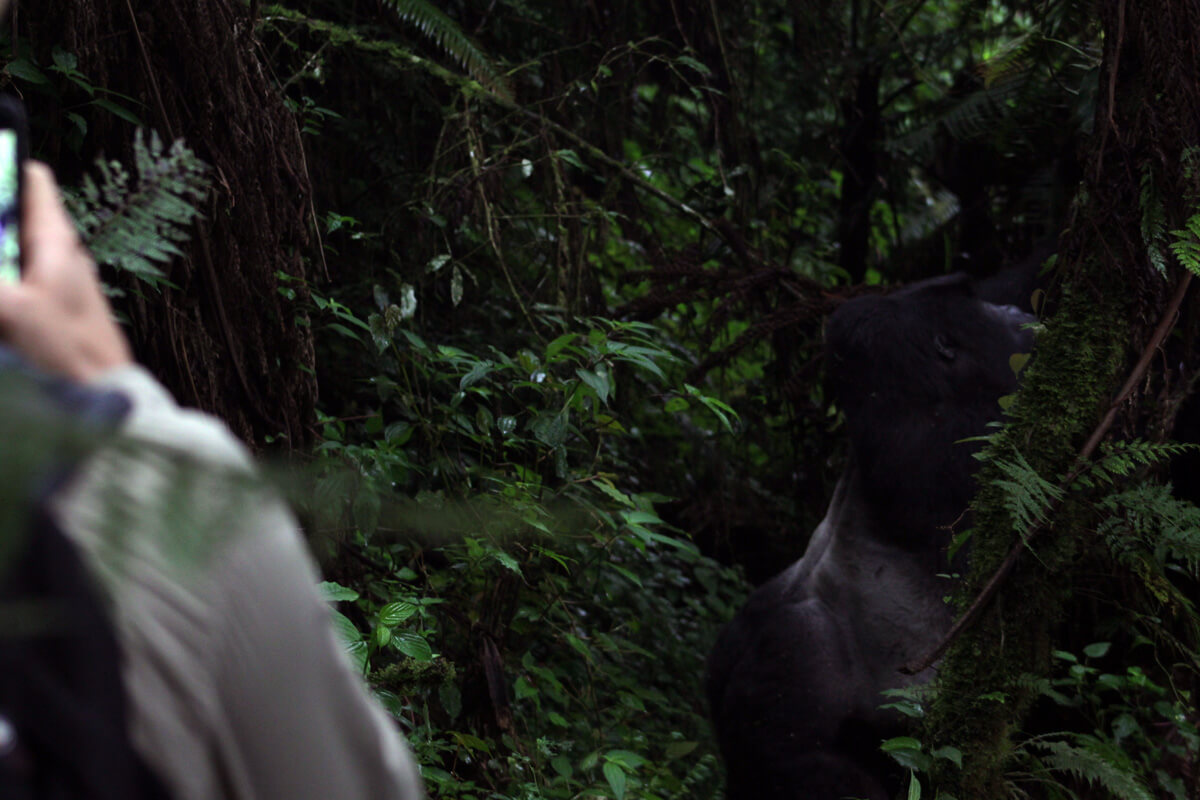
For someone who has never seen gorillas but would love to, there are always so many questions running in their mind. Maybe it is about safety or the price or any other requirements. With this article, we want to answer some of those frequently asked questions about gorilla trekking - all in one place.
Definitions
1. What Is Gorilla Trekking?
Gorilla trekking is the activity of hiking (1 to 4 hours) that is done in search of the mountain gorillas in their natural home. Gorilla trekking is interchangeably called gorilla tracking.
The hike goes through very thick and lush rainforests and steep slopes until you reach the assigned group of gorillas. The entire hike might take you 1 to 4 hours of walking to reach the gorillas - depending on where they slept the previous night.
2. What Is The Difference Between Gorilla Trekking And Habituation?
The difference between gorilla trekking and habituation lies in the group of gorillas visited and how familiar they are with humans. Gorilla trekking involves visiting a family of gorillas that is used to seeing humans regularly. On the other hand, gorilla habituation brings you in contact with the gorillas which are still getting acclimated to human interaction - still being habituated.
For the common gorilla trekking, you will see gorillas that are used to human interaction after years of training (habituation).
With gorilla habituation, you get to spend around 4 hours with the gorillas, unlike gorilla trekking where you spend up to 1 hour with a given gorilla family.

Time & Place
3. Where Can I See Mountain Gorillas?
You can only see mountain gorillas in Uganda, Rwanda, and the Democratic Republic of Congo. Mountain gorillas can only survive in the environment and ecosystems of Southwestern Uganda, Northwestern Rwanda, and the neighbouring DRC.
In Uganda, you can see mountain gorillas in the two national parks - Bwindi Impenetrable National Park and Mgahinga Gorilla National Park.
In Rwanda, you can see gorillas in Volcanoes National Park. In DR Congo, you will see gorillas in Virunga National Park.
Beyond these 4 national parks, you will not be able to see any mountain gorillas anywhere else in the world. The lowland gorillas are the kind you will find in a few zoos around the world.
Where Can I See A Silverback Gorilla?
When you see gorillas, you will not miss the silverback. Gorillas live in families headed and protected by a dominant silverback. This means that wherever you go gorilla trekking, you will see a silverback gorilla.
The park ranger will identify and show you the silverback. You will notice a silverback gorilla by its massive size, grey (silver) hair on its back and the calm confidence of a leader.
Related Article: Where to see mountain gorillas in the wild.
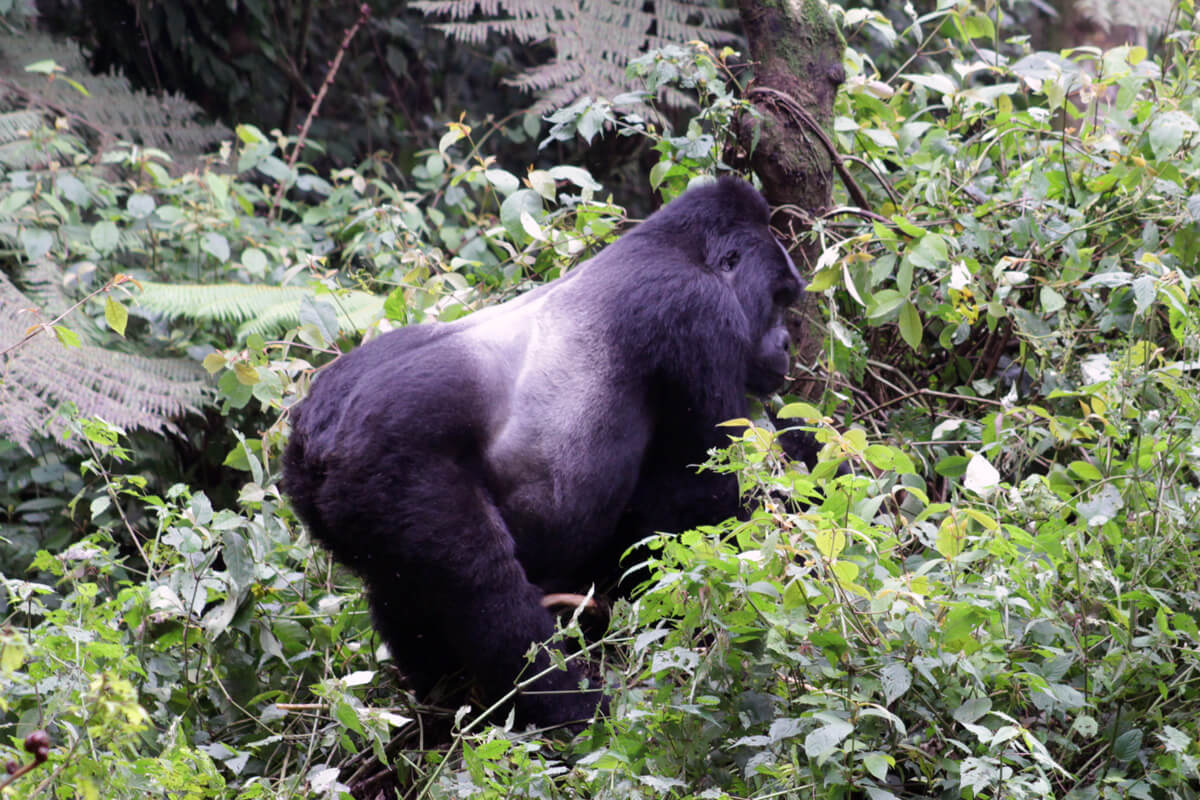
4. Is It Better To See Gorillas In Uganda Or Rwanda?
This is a matter of opinion and preference. Meeting gorillas is not an experience that gets old and some people who have trekked gorillas several times in both Uganda and Rwanda couldn't tell which is better.
The easier comparison might be on the hiking intensity for the hikes as well as the other activities which are included as part of your trip. If you are doing several other activities in Rwanda, then it is the better option. Likewise, if your trip involves activities in Uganda, why not track the gorillas there?
Another consideration could be the cost, but that is covered later in the article.
5. What Country Has The Most Gorillas?
Of the three countries which have mountain gorillas, Uganda has the largest number. This is because Uganda has 2 national parks that are home to the mountain gorillas.
On your visit, you only visit a single family of gorillas. This is why for someone planning a gorilla trekking safari, it might not matter which country has the highest numbers.
6. What Is The Best Time For Gorilla Trekking?
The best time for a gorilla trekking safari is between June and October. This applies to all the countries - Rwanda, Uganda, and DRC. This is the dry season time with relatively light rains.
Since gorillas live in natural rainforests, the dry season doesn't mean that there is no rain - just lighter showers and at times some rainless days.
The good thing is that this is during the summer months when travel peaks all over the world - which means you will get to share your experience with new friends.
We have to mention, that you can still do gorilla trekking at any time of the year. The weather in the forest is highly unpredictable and it shouldn't make you change the schedule of your planned visit.
Safety
7. Is Gorilla Trekking Safe?
Given the size and strength of a gorilla, many people ask if gorilla trekking is safe. Gorilla trekking is a very safe activity and we don't know of any bad incidences between the gorillas and tourists.
The first activity of your gorilla trek is a briefing from the park officials. In this briefing, they will tell you about the things you are not supposed to do around gorillas.
This briefing is usually intended to make sure that the safety of everyone (and the gorillas) is ensured. On your hike, you also get accompanied by an armed park ranger - to make sure everything goes according to plan.
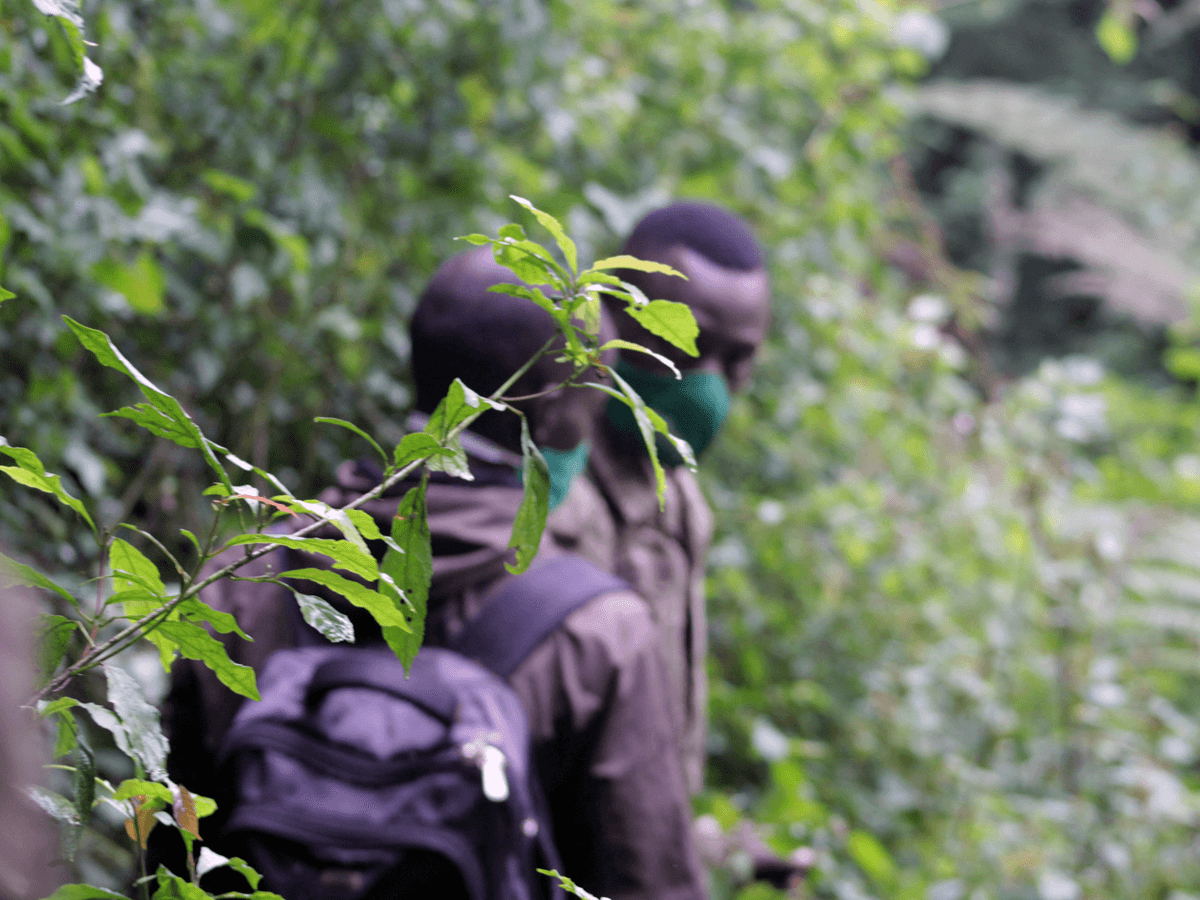
Since the gorilla group you will visit is habituated, they are used to seeing people regularly and are safe to be around. They are called "Gentle Giants" for good reason.
Lastly, you have to remember that the gorillas are wild animals and no one can guarantee their actions. It is best to follow the guidelines of your ranger.
Is It Safe To Go Gorilla Trekking In Uganda?
Yes, tracking gorillas in Uganda is very safe. All the above measures and guidelines apply to Uganda and Rwanda.
As far as national security, Uganda is very stable and the people are warm and welcoming.
Related article: Is Uganda safe to visit?
8. Are Gorillas Friendly?
It is hard to answer whether gorillas are friendly or not. They are not aggressive but not as playful as the golden monkeys. Gorillas are very calm beings and they exude that calmness when you see them.
In the case of the people they see more regularly - such as rangers and researchers, gorillas might be quite playful. This is mostly the young ones.
Let us go with this, " Gorillas won't make you feel unwelcome in their home ".
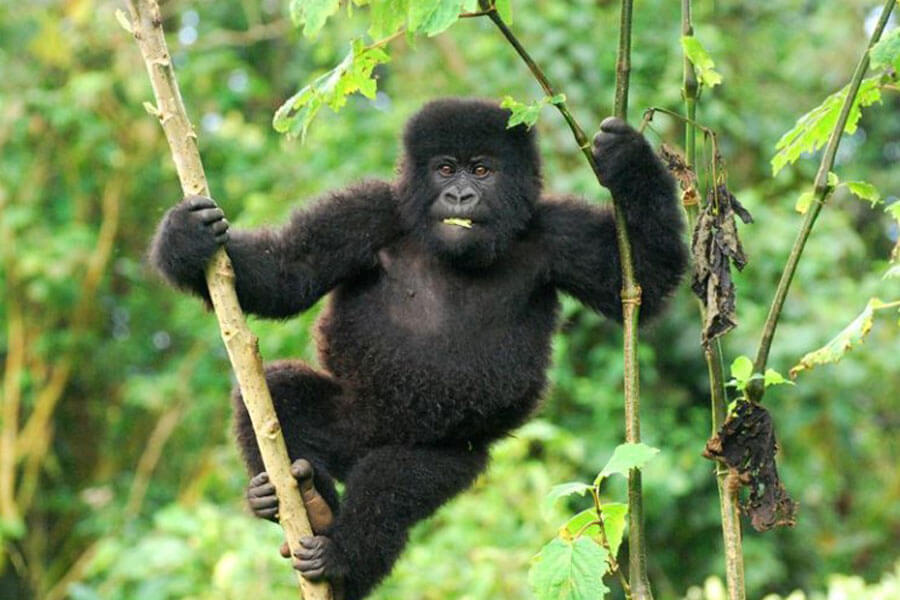
9. Can You Touch The Gorillas?
No, you can not touch gorillas. Generally, you stay some feet away from the gorillas. This is for both safety and health reasons since humans and gorillas can transmit some communicable diseases.
However, if a gorilla comes to you, you are advised to stay calm. The young ones are more likely to approach you but it is not a regular occurrence.
If you are lucky to get approached and calm enough that it stays longer - then you might end up touching a gorilla, albeit briefly.
While the above possibility is mindblowing, be aware that it is rare and you shouldn't really expect it. Maybe pray for it? It's all up to you.
Related article: Gorilla tracking rules, regulations& guidelines for visitors
Gorillas & Conservation
10. How Smart Is A Gorilla?
Gorillas are smart and can learn sign language and how to use tools. Gorillas are our closest relatives after chimpanzees and possess well-developed brains.
When you notice the way gorillas are organized in their family units, you realise that they are smart animals.
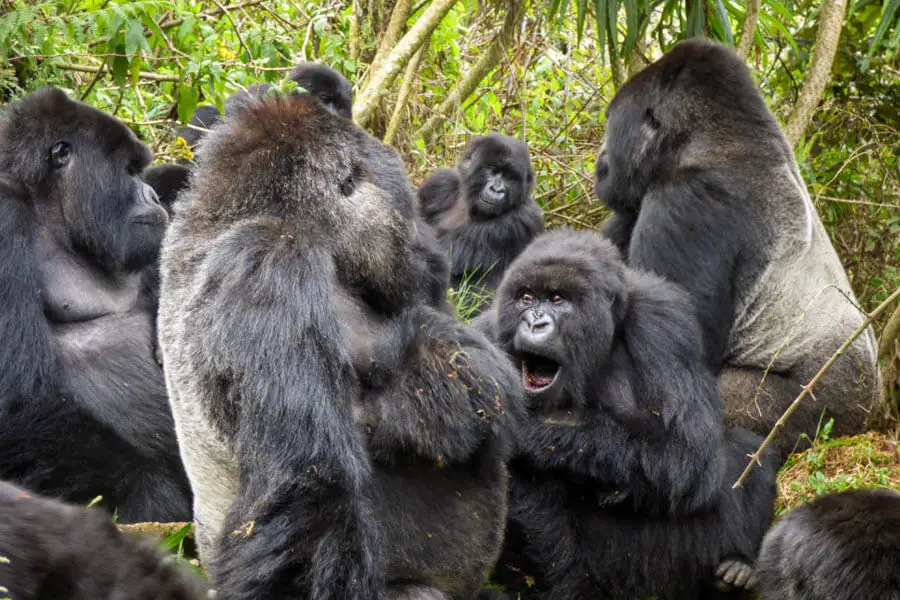
11. How Many Mountain Gorillas Are Left?
There are slightly more than 1,000 mountain gorillas left in the world - as of the last official gorilla census in 2018. Since the census, many groups in Uganda, Rwanda and DRC have registered newborns and the numbers are still growing.
12. Is Gorilla Trekking Ethical?
We honestly believe that gorilla trekking is ethical. But some people could argue the opposite.
Gorilla trekking raises money that directly goes towards conservation activities like research, monitoring, and protection of the ecosystem where gorillas live. Without gorilla trekking, the rising population of gorillas might not have happened.
It is because of gorilla trekking that local communities can actively get involved in the conservation of the gorillas and the places they inhabit.
We think these are pretty solid reasons - and they are not the only benefits. You can talk to us about your ethical concerns and maybe we can provide a good answer.
Packing & Fitness
13. What Should I Take/Pack For Gorilla Trekking?
Your packing list for gorilla trekking should generally prepare for the terrain and weather. Here is a simplified list of what you should carry when you go to see gorillas.
- Comfortable walking shoes
- Long sleeve shirt/blouse
- Long [tuckable] pants
- Light rain jacket
- Water bottle
- Snack / Energy bar
- Sunscreen
- Bug/Insect repellant
- Hat [wide brim]
14. How Difficult Is Gorilla Trekking?
Gorilla trekking is far from a walk in the park (even though you are actually in a national park). Gorilla trekking is a challenging activity that requires an adequate level of physical fitness.
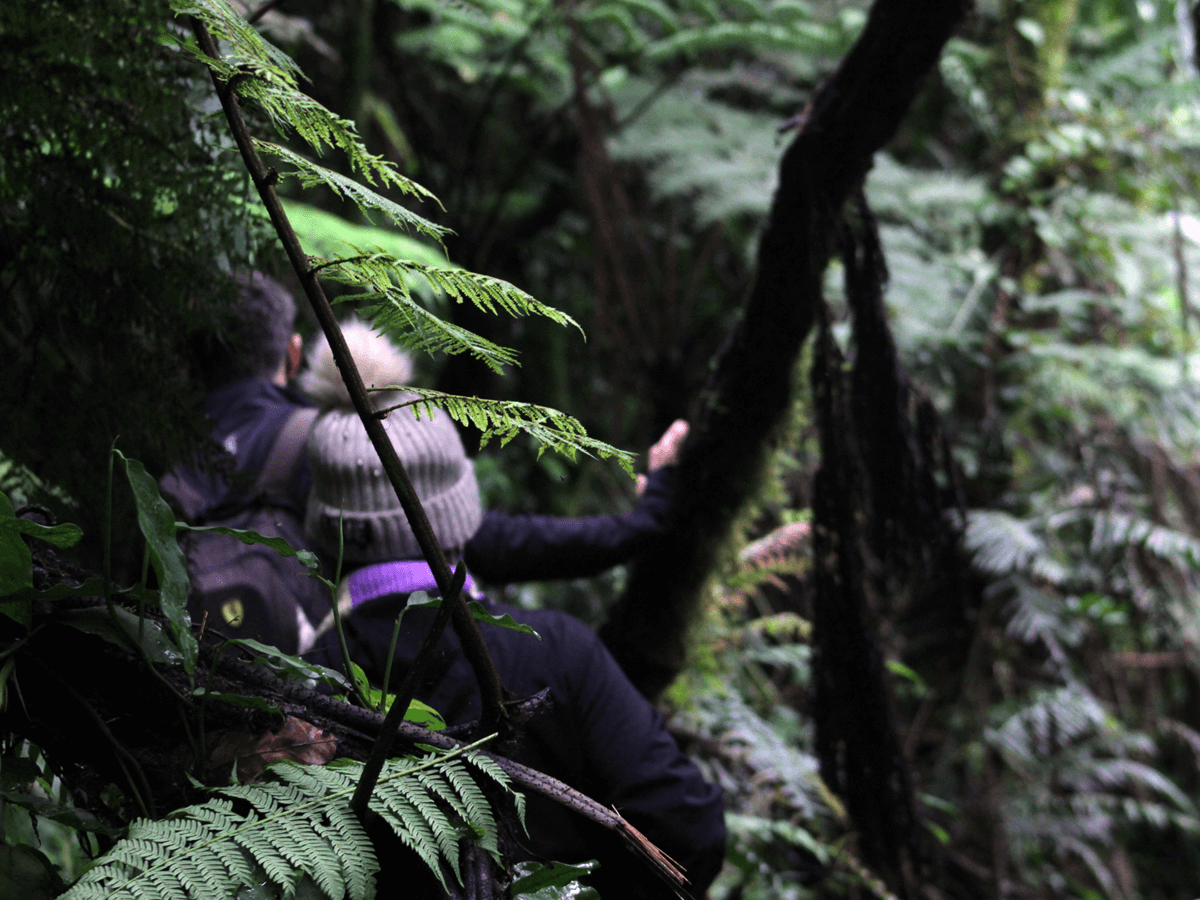
The hike goes through thick forests, steep hills, and valleys as well as swampy areas. It is much much more than hiking but of course, the reward is worth it. The hike can take as short as 1 hour when the gorillas slept close to the starting point the previous night. The hike can easily stretch on for 4 hours because the gorillas move however they want without anyone stopping them.
For people with physical disabilities, an area with easier terrain can be specifically chosen as well as being assigned the nearest groups. People who can't walk can also hire local porters to carry them through the thick forest.
Cost of Gorilla Trekking
15. Why Is Gorilla Trekking So Expensive?
The biggest thing that makes gorilla trekking expensive - compared to other safari activities is the conservation fees. Conservation fees are what is paid to the government bodies in charge of protecting and safeguarding the national parks where these endangered gorillas live.
These conservation fees are paid in the form of a gorilla trekking permit. Without this gorilla permit [for a specific day] you cannot track the gorillas.
16. How Much Is A Gorilla Permit In Uganda?
In Uganda, a single gorilla tracking permit costs 800 US Dollars. This is the conservation fee mentioned above.
In Rwanda, the cost of a gorilla permit is 1500 US Dollars, while a gorilla permit in DRC is 400 US Dollars.
| Country | Locals / EAC | FOREIGN RESIDENTS | FOREIGN VISITORS |
|---|---|---|---|
| Uganda | 300,000 UGX | 700 USD | 800 USD |
| Rwanda | 200 USD | 200 USD | 1500 USD |
| DR Congo | 200 USD | 200 USD | 400 USD |
As you can see, different countries charge different fees for their gorilla permits. When you do decide to see some gorillas, this is an important consideration to factor into your decision of the country to visit - among other reasons.
17. Is Gorilla Tracking Worth The Money?
We think that gorilla trekking is worth it. But we wouldn't want you just deciding based on that, so here is how you can weigh the choice for yourself.
- Check out some online reviews of gorilla trekking on sites like TripAdvisor.
- Ask some friends or friends of friends who have done it and get their personal views.
- Get in touch with a local tour operator you can trust and ask them about how you might be able to keep the cost down
You can also talk to us and we'll ask our tour operator friends about making your gorilla trekking as budget-friendly as possible.
Related article: Gorilla trekking on a budget. Hacks to help you see gorillas on a tight budget
18. How Much Does A Gorilla Safari Cost?
There is no best answer to how much a gorilla safari costs. This is because an entire safari consists of several other things such as transport, accommodation, driver fees, international flights and the standard gorilla permit.
Closing Thoughts
Was this article helpful in answering some [or all] of your questions about gorilla trekking? We hope it was but if you have any other questions, don't hesitate to ask. We'll try to help you get all the answers and information you might need for an African safari adventure.
As we are not tour operators, we'll give you unbiased answers and recommendations. And if you want a tour operator we would use ourselves, just ask us.
